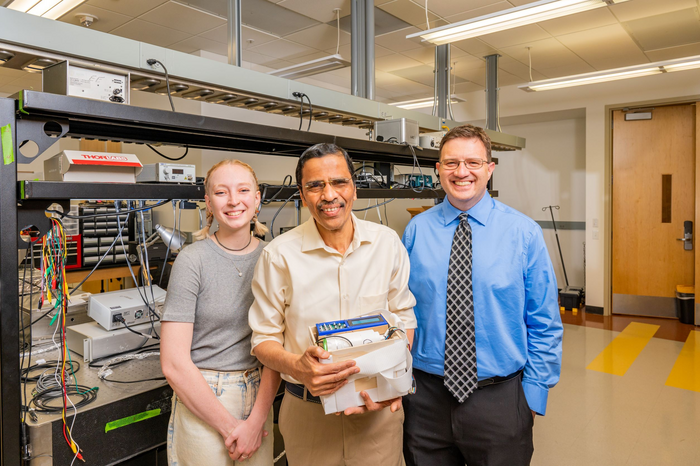A team led by a University of Texas at Arlington bioengineering professor and an Austin businessman has published key findings in the British Medical Journal Innovations that illustrate how a new device measures hemoglobin more accurately in individuals with darker skin pigmentations.

Credit: UT Arlington
A team led by a University of Texas at Arlington bioengineering professor and an Austin businessman has published key findings in the British Medical Journal Innovations that illustrate how a new device measures hemoglobin more accurately in individuals with darker skin pigmentations.
George Alexandrakis, UT Arlington bioengineering professor, and Dr. Vinoop Daggubati of Shani Biotechnologies LLC conducted a clinical study at UT Arlington with 16 healthy volunteers and measured their hemoglobin and oxygen content using the newly developed technology. The team compared the results to those obtained using a commercially available pulse-oximeter for accuracy and variability.
Racial disparities in hemoglobin and blood oxygen measurements are an urgent public health issue. Currently available devices are inaccurate in people with dark skin. The U.S. Food and Drug Administration has issued a safety communication and organized an advisory committee meeting on Nov. 1, 2022, to discuss this issue at length.
The findings from the UTA team’s research are encouraging, and the new technology has massive potential to address this clinical unmet need. Alexandrakis said their intent is to develop a wearable device, such as a watch or a monitor, that would read the blood through the skin.
Most currently available methods for monitoring hemoglobin require blood samples and expensive equipment. The available noninvasive spectroscopic methods have a high degree of variability and often are inaccurate in people of color due to differences in skin melanin. There is a significant unmet need for a reliable, noninvasive device to estimate hemoglobin, irrespective of skin color.
Currently available pulse-oximeters use red-infrared light and are based on technology first designed more than 50 years ago. In contrast, the team’s device relies on the spectroscopic properties of hemoglobin in the blue-green light spectra.
“We have used the green-blue light and have successfully tested the device in preclinical and clinical studies,” Daggubati said. “Our group has addressed the issues around shorter wavelength, scattering of light and the impact of skin melanin. The scientific community should open its mind to the concept of green light for these measurements. The Shani device has huge potential to eliminate this racial disparity.”
Method of Research
Randomized controlled/clinical trial
Article Title
Innovative technology to eliminate the racial bias in non-invasive, point-of-care (POC) haemoglobin and pulse oximetry measurements




